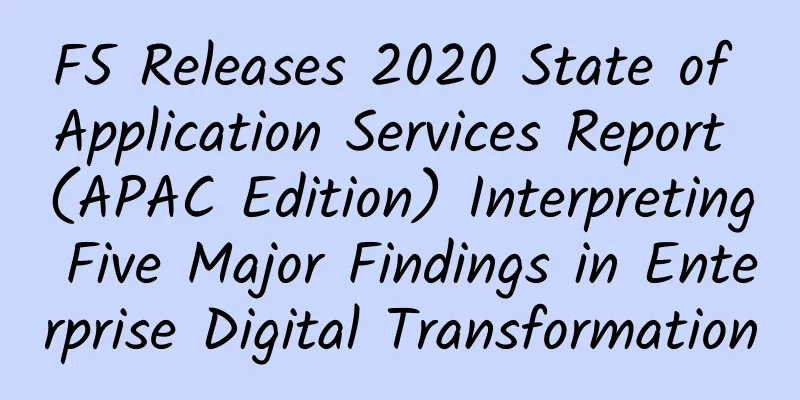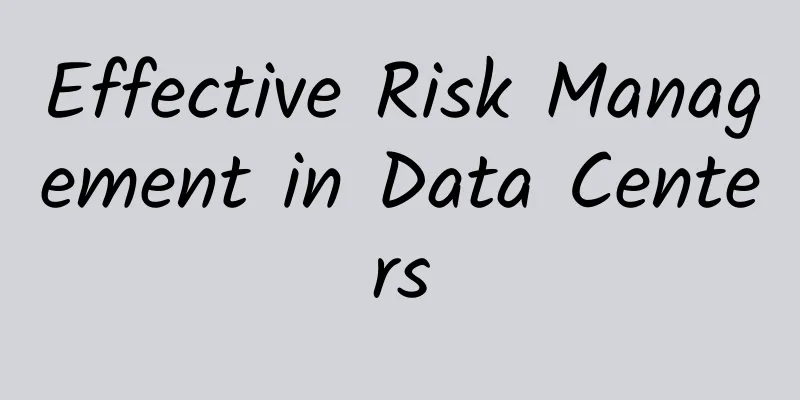F5 Releases 2020 State of Application Services Report (APAC Edition) Interpreting Five Major Findings in Enterprise Digital Transformation

|
[51CTO.com original article] F5 Networks recently released the "2020 Application Service Status Report (Asia Pacific Edition)" in the industry. Since 2015, F5 has released an annual application service status report. This year's report invited more than 1,300 IT practitioners from different positions in enterprises in the Asia Pacific region to participate, providing a unique perspective for people to understand the trends that shape the application landscape and how to meet the changing needs of the digital economy through transformation.
Wu Jingtao, technical director of F5 Greater China, told 51CTO that the application services mentioned in this report by F5 are no longer a narrow concept, but all service functions that may be needed in the entire process from code generation to client access after an application is built are included in the scope of application services. Wu Jingtao then explained in detail the five points of information observed in this report to the reporter.
Wu Jingtao, Technical Director of F5 Greater China Finding 1: 82% of organizations in Asia Pacific are implementing digital transformation and are increasingly focusing on accelerating time to market. Digital transformation makes enterprise applications become truly core assets. As digital business activities mature, organizations are working to integrate digital services from previously unrelated industries or market segments and create value by building new ecosystems. According to feedback from interviewed executives, cloud, big data analysis, and automation and orchestration will become the three major strategic trends in the next two to five years. "In the survey, F5 found that most of the enterprise customers in the Asia-Pacific region have gone through the first stage of digital transformation and realized digital IT and business process automation. They are currently transitioning from the second stage to the third stage. That is, they have begun to use orchestration to expand the processing of the entire process in a multi-cloud environment to achieve greater business value, and gradually provide business insights through the telemetry data streams of application services to truly realize business value." Wu Jingtao said that it is time to manage the application portfolio like managing business assets. Once the enterprise reaches the third stage, the organization will be able to use cloud analysis tools to study these data streams from application services to obtain practical operational and business insights, such as predicting capacity, preventing loss, and providing differentiated customer experiences. Finding 2: 86% of organizations in Asia Pacific have adopted multi-cloud architecture, and most face security challenges. In the long run, multi-cloud will eventually become the norm. Wu Jingtao pointed out that in the survey, 39% of users believed that the choice of cloud was up to the application itself. This is true. If customers want to develop financial services, then Alibaba Cloud is a very good choice because the payment gateway is very smooth; if customers want to expand overseas markets, then most companies will choose AWS; if they want to make games and connect to WeChat public accounts and mini programs, then Tencent Cloud is the most convenient; and many Internet celebrities will choose Kingsoft Cloud for live broadcasts because Kingsoft Cloud optimizes the transmission of video streams very well. "This 'depends on the specific application' strategy is necessary because each application is different and serves a specific function in the enterprise; the end users of each application may grow from less than a hundred to millions; and each application faces different risks, ranging from common vulnerabilities to reputation damage to billions of dollars in losses." Wu Jingtao emphasized that in order to provide personalized application services and implement application operations and protection across heterogeneous architectures and environments, the most efficient and effective way is to adopt a series of application services that can abstract application logic from the underlying infrastructure. Finding 3: 71% of companies in Asia Pacific improve efficiency through network automation. In this environment of speed to market, network automation levels continue to increase as organizations seek greater speed and consistency. Compared to previous years, automation has been more consistently applied in the deployment pipeline this year, reaching 39% in almost all four component areas (application infrastructure, application services, network and security), indicating that its maturity is increasing year by year. Finding 4: 68% of enterprises in Asia Pacific use more than 10 application services. Wu Jingtao told reporters that in the process of investigating application services used by enterprises, F5 found that 4 out of more than 10 application service areas were related to security, namely SSL VPN (80%), firewall, IPS/IDS, anti-virus software and spam defense and other common security services (75%), WAF (68%) and DDoS protection (67%). This shows that security still dominates. Moreover, as cloud-native and container-native application architectures mature and expand, more and more organizations are beginning to deploy related application services on-premises and in public clouds, such as Ingress control and service discovery. Modern applications require modern application services to meet their scalability, security, and availability requirements. Finding 5: 63% of organizations in the Asia-Pacific region hand over application services to IT operations teams, of which more than half are managed by DevOps teams. As application services continue to shift to modern architectures, cloud and container-native applications are more dependent on infrastructure for scalability and availability than previous application architectures in many ways. Since DevOps teams are closely related to CI/CD pipelines, as organizations move from single functions to modern operations-centric team structures, the focus of responsibility is also shifting from IT operations and NetOps to SecOps and DevOps. This change reflects that the maturity of DevOps is about to rise to another level, and DevOps teams will be expected to take more responsibility for application protection, optimization, and management. When the reporter asked why half of the companies did not choose to hand over their application services to the DevOps team since DevOps has obvious advantages, Wu Jingtao explained that enterprise users actually face many challenges in the process of implementing DevOps. The first challenge is the ability to develop code. Many enterprise customers' applications are developed by outsourcing teams, so if enterprises want to manage data in their applications, it will be difficult; the second challenge is that in the organizational structure of many companies, the R&D center, testing center, and production center are strictly separated. All development and iteration work must be based on stability as the primary premise, and damage to services is not allowed. Therefore, it is difficult to transfer the main business to the DevOps model; the third challenge comes from the management structure. Unlike the business department of Internet companies, many enterprise users need to make unified decisions and need different departments to collaborate, which is difficult to match with the "short, flat and fast" style of DevOps. "At present, many companies in China are trying the DevOps model, but there are not many companies that can really complete it, and most companies are still exploring." Wu Jingtao concluded. At the end of the interview, Wu Jingtao also talked about the Chinese characteristics of this report. He told reporters that in this survey, Chinese respondents showed great enthusiasm and enterprising spirit, and many Chinese figures are basically close to or on par with the global level. More than 20% of Chinese respondents said that their organizations already have more than 1,000 applications, a number comparable to the global level. In other words, on the road to digital transformation, the global average is basically the same as the Chinese level. He particularly emphasized that Chinese users attach much more importance to the speed of product launch than the global perception. Many Chinese companies believe that factors in market competition can be weakened first. What is important is to quickly bring products to market. "F5 and our customers have the same needs. In the future, F5 will work hard to create products and build solutions to help customers move from the second stage of digital transformation to the third stage as soon as possible and achieve a better IT digital transformation." Click the link below to download the full report: https://www.f5.com/c/apcj-2020/asset/state-of-application-services-report-download-form-apcj-cn?utm_campaign=soas2020apcjreport&utm_medium=social&utm_source=wechat [51CTO original article, please indicate the original author and source as 51CTO.com when reprinting on partner sites] |
<<: Ten underutilized SD-WAN features
Recommend
Home Wi-Fi Routers and Extenders Market to Reach $18 Billion by 2030
[[420910]] Market Introduction Market research fi...
818 Cloud Go: Tencent Cloud offers cloud servers starting from 74 yuan/year, 1C2G5M for three years starting from only 288 yuan
As June begins, all major online platforms have l...
5G is coming, these 10 common things will disappear in the future
Hello everyone, I am a senior. Recently, you may ...
5G-driven digital transformation solutions
[[428116]] 【51CTO.com Quick Translation】 Accordin...
LOCVPS 20% off, Hong Kong Cloud/Confederation VPS bandwidth upgrades at no additional cost
LOCVPS released the promotion information for Jul...
What does Huawei's ultra-high-density UPS module mean to data centers?
[51CTO.com original article] With the continuous ...
LOCVPS: 30% off US XEN architecture VPS, 20% off all VPS, Japan/Singapore XEN architecture monthly payment starting from 29.6 yuan
LOCVPS sent a promotional plan for XEN architectu...
What is the difference between a free SSL certificate and a paid one?
With the popularity of SSL certificates, CA agenc...
UCloud Double 11 Carnival, AMD models are replenished in large quantities, Hong Kong 2C4G2M cloud server starts at 287 yuan/year
UCloud's Golden Autumn Carnival event has end...
Enlightenment on using Smallcell to solve deep network coverage in the post-5G era
1. Current status of network coverage in the post...
Huawei's Li Jie: Leading with innovation and continuously consolidating high-quality 5G networks
[Shanghai, China, June 5, 2023] At the 2nd Mobile...
[11.11] CMIVPS recharge 10% off, 30% off for all VPS annual payments, buy 10 months of dedicated server and get 2 months free
CMIVPS released this year's Double 11 promoti...
Yecaoyun Hong Kong High Defense VPS, starting from 122 yuan/month-dual core/2GB/15G SSD/5M/50G defense
Yecaoyun recently launched a new high-defense VPS...
Overview of the Latest Data Center Network Architecture Technologies
The network is the most important part of the dat...
The price of 4G mobile chips will rise instead of fall in the second half of 2021
As mobile chip suppliers focus more on 5G solutio...









